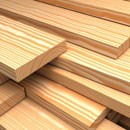Here's How: An Air/Water Barrier Stops Wood Rot
Dear James: I am planning a new room addition to our home. I have heard a lot about serious rotting of the lumber in the walls. How can we be sure to avoid the moisture and frame rotting problems? -- Beth R.
Dear Beth: Moisture damage can be a serious problem, but there are several methods to block the moisture to eliminate possible damage. When wood gets damp and stays damp, fungi attack the wood and cause the rotting. Slight dampness cannot be totally eliminated, but if it dries out in a reasonable period of time, the lumber will not be damaged.
The moisture problems that you have heard so much about are probably from the application of synthetic stucco to the sheathing on walls. If installed properly, it is an attractive and durable method to finish the exterior of a house.
If done improperly, leaks can develop and allow some water to get behind the synthetic stucco coating. It often enters where the stucco was not sealed properly around window and door openings. Once inside the wall cavity, the moisture is trapped and the wood quickly rots. In some homes, the rot is so bad that the entire wall has to be rebuilt.
Installing a moisture barrier first, before the exterior finish, is the best insurance against any possible rotting of the wall lumber. In the olden days, asphalt-saturated roof felt was used as the moisture barrier, and it was effective. For a period of time, its use fell out of favor with builders, and many existing homes have no moisture barrier.
Felt is available in fairly narrow rolls, about 3 feet wide, so several layers are needed to cover the entire house. Start wrapping from the ground level. Position the next layer so that it overlaps the first layer by about 3 inches. This large overlap keeps the moisture flowing down and over it without backing up from capillary action and getting behind the felt.
Within the past 20 years or so, several newer moisture barrier film materials have been developed. They are available in up to 10-foot-wide rolls to cover the entire wall with one piece. The material cost is higher than when using felt, but the overall installed cost is less because of the reduced labor when installing the newer materials.
Most building supply outlets should carry rolls of these materials, or you can contact these companies: Celotex, Dupont Tyvek, Johns Manville, Owens Corning, Pemko Mfg., and Protecto Wrap.
These newer moisture barrier films are also excellent air barriers to stop air leakage into and out of your walls. Although the air and water are blocked, the films still allow some water vapor to breathe through them. This is important to give any excess moisture an escape route back outside and out of the wall cavity.
When you or your builder buys a roll of any of these moisture/air barrier films, make sure to get some of the special tape to seal the joints. These tapes are specially designed to provide long-term adherence to the films. Standard tape is less expensive, but it will not hold up as long. To cover a typical house with film, the entire installed costs may be in the $300 to $400 range.
There are a few key installation details to keep in mind for an effective moisture barrier film. It should overlap the outside of the foundation by several inches. Do not stop it at the top of the foundation because the water may stand there and leak indoors.
Another important area to consider is around door and window frames. The film should overlap the frames. Many new windows have nailing flanges for simple installation. It also would not hurt to let the film overlap the window flange and then tape it to the flange.
========
Send your questions to Here's How, 6906 Royalgreen Dr., Cincinnati, Ohio, 45244 or visit www.dulley.com. To find out more about James Dulley and read features by other Creators Syndicate writers and cartoonists, visit the Creators Syndicate website at www.creators.com.
Copyright 2024 Creators Syndicate Inc.






























Comments